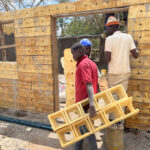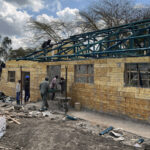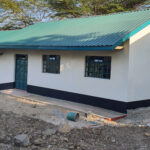Globally, there are nearly 1 billion people, or 1 out of every 8 of us, who do not have access to adequate permanent shelter. It’s a problem that feels overwhelming, but one Pittsburgh-based startup is striving to put good housing within reach for many more.
For the past seven years, Onsite ICF has been developing a machine that can quickly and inexpensively generate building components and that can fit on the back of a pickup truck. This means that companies in less wealthy, rural regions of developing nations can build durable and inexpensive new homes onsite, using mostly locally sourced materials.
The machine creates ICFs (insulated concrete forms) using a two-part polyurethane foam. Once the forms, or blocks, are generated, homes can be assembled quickly and with a minimum of additional building supplies. The finished homes are insulated, pest-repellant, and sturdy enough to withstand the most extreme weather.
During July 2022, a pilot project in Kenya constructed a new school building (pictured below) at a cost that was about 25% less than the next best building method. In March 2023, Habitat for Humanity asked Onsite ICF to be their preferred contractor for all of Kenya, where they are projecting to build 90 houses between march and November 2023, using around 65,000 of the 100mm ICF blocks.
The following conversation with Steve Ross, Onsite ICF Managing Director and engineer, and Drew Degentesh, Daedalus principal and engineer, explains the work they’ve done together developing the technology that will fulfill Onsite ICF’s mission.
Part 1: Steve Ross, Onsite ICF Managing Director and Engineer
Jenn Scott: Tell me a little about yourself and what inspired this project.
Steve Ross: I’m an electrical engineer by profession and I had the idea of getting involved with organizations that were bringing electricity to people that never had it. So I asked the executive director of an organization that I knew of, “Do you have any opportunities in energy access?” And he said, no, but let me show you this housing project that we’re working on.
We went to Tijuana, Mexico and we looked at a rudimentary version of a system that was intended to make construction blocks out of polyurethane foam.
At the time I was still in the family business and I took this project on as kind of a work-for-hire sort of a project. It looked interesting and I felt like I could help. That was in 2016.
JS: Tell me a little bit about the company’s goals.
SR: Big picture, putting good housing within reach. This is not the cheapest way to build a house, but it is a good house. I want to create a step change from the status quo in the global housing space by creating a house that people will aspire to own. It’s comfortable, it’s durable, it’s safe—I would say even beautiful. I want to make a house that’s good enough or so good that I’d want my own family to live in it.
JS: What did the early steps look like?
SR: It was very slow going in the early steps. I tried to improve upon the ideas that I had seen. It took probably a year for us to get our first prototype machine going. We just tried a lot of things that did not work and it was trial and error.
Then we had to do some cost reduction in the design of the block and we involved a prototype shop. And that was still complicated—their expertise was in one-of-a-kind special [builds]. What we ended up with was expensive and not easily manufactured at any kind of scale.
JS: At what point did you seek out Daedalus? What role were you looking for them to fill?
SR: I’ve been working with Daedalus for about three years now. At first, I thought I just needed some CAD work to just make 3D models and drawings from the design that I already had.
But ultimately the machine [at that time] just didn’t work all that well. We’d refined it and we had a model that we thought would work, took it to the field, and our reaction was: “We can do better.”
So at that point, I kind of took the chains off and gave Drew [Degentesh] a lot of latitude to figure out what we could do differently to just make this simpler.
JS: What has it been like working with Daedalus?
SR: It has been very efficient. Drew has been my primary point of contact and we have zeroed in on good design pretty quickly. They’ve been responsive and clever.
Beyond that, [Daedalus] has a network of resources. We ended up making the two main parts of the mold out of aluminum castings and Drew knew who to talk to and what the possibilities were with that. That really sped up the whole prototyping process and was cost-effective. I think that’s something [Daedalus] brings to the table that needs to be appreciated.
JS: What were some of the unique challenges of this project? Unique successes?
SR: This is a product that needs to work in remote places. It cannot be sophisticated, it cannot be custom-made parts—they are going to need frequent replacement due to wear and tear. It can’t use much electricity because there’s limited electrical capacity where these things operate.
The goal was to make the whole process simpler. And I am really proud of what we came up with. Working with Drew, I think we evolved into a good working relationship and kind of a synergy of ideas and an understanding of where we needed to go.
We took a unit that weighed 600 pounds and had I don’t know how many different parts and we ended up with a unit that weighs one-fourth that. The cost went way down. We used castings and other types of off-the-shelf bolts and tools and jacks and clamps and ended up with something that was really streamlined and slick.
JS: Could you tell me a little more about the system itself? How much does it cost?
SR: One of these systems can produce 600 blocks per week. That house that’s in the video. uses about 250 blocks. So call it 300. So that’s about two of those houses per week, a hundred houses per year.
The system costs about $50,000. Half of that is in the four molds and the other half is in spray equipment. I think it would probably last about five years, so amortizing that over the blocks per year, it’s a reasonable expense.
The prototype house was built with the equivalent of a 55-gallon barrel of polyurethane.
JS: The whole house?
SR: Yeah. All those walls. So it’s pretty cool. And you think about when they do that with concrete blocks, how much that’s going to weigh? And this was done with polyurethane. Well, you need an A and a B part, right? So technically two barrels, but half of a barrel of each.
JS: How long did it take to get the whole house together?
SR: Unfortunately I’m not going to have a real clear answer for you on that because I contracted out the roof and the floor. I can tell you that the walls took about 48 hours.
This did not include making the blocks; with the system, we do about 20 blocks an hour. Start to finish, it was probably three or four months.
But the goal is, and I’m sure this can be done, that house could be built in a week by a volunteer crew of like 10 people.
JS: Could you explain a bit about the process and why you’re using the materials you’re using?
SR: Polyurethane is good because it is a self-reacting chemical. You mix the two parts together and it reacts and turns into foam. [When used in the mold] these are like cement blocks, but made out of foam and they stack together like Lego blocks with rebar. And then we fill [the stacked blocks] up with concrete to grant the structure.
So you think about building this house in places where they have earthquakes or hurricanes or both of those natural disasters—this will hold up during those kinds of natural disasters. It’s pest-resistant and it’s insulated.
JS: What are some of the most surprising things you learned from this project?
SR: I have been surprised at the global housing shortage—just how massive that is. We say in the first video [on the website], there’s 860 million or something close to a billion people that don’t have a shelter.
I’ve been doing a lot of market research in Kenya. They are short 200,000 housing units per year, the population is growing faster. So people end up living in informal settlements or they live with their extended families. There’s a real need for affordable housing. And we may have a bridge solution, but if people can’t afford it or can’t get financing for things it’s going to be constrained.
Another surprising thing we’ve learned in this is something they call incremental housing or incremental building. A lot of people don’t have bank accounts, so they’re not saving money. So what they’ll do is save up building materials—they’ll buy bricks and they’ll buy a sheet of steel or some rebar and just pile it up until they have enough material to add a room onto their house.
So there’s a couple of ways I’m looking at this [as a business model]: one way would be like a local construction company so they can own and operate the machine and use it to build the buildings that they build. A different model would be to have an entrepreneur setting up the block-making as their business so they just make blocks and then they can sell blocks to whomever.
JS: Is it primarily Kenya that you’ve been looking at or are there other areas?
SR: I’m looking at a lot of places. Puerto Rico is another place that I’m trying to get into because they get hurricanes and earthquakes. Dominican Republic, The Philippines, I think there is use for this and I have some connections there. But that conversation is moving slowly.
I talked with Pakistan recently, I have a connection there and it has a team of people year-round and they are really giving this a serious look.
JS: Is there a possibility of this also being used domestically as well as abroad?
SR: You know, that’s a great question and I’m glad you asked that. Frankly, my focus has been overseas. Structurally, [the house] is sound, but from a [US housing] code perspective, there’s some homework I have to do to get that done. For now, I’ve got my hands full with everything else.
JS: What have been your favorite parts of this project?
SR: It’s just fun to see things work. That’s the joy of engineering, right? You have an idea and it works. And I personally had a hand in making every one of the blocks that went into the house. Having done all of that, I am more excited about this. Not less excited. This is really cool. And it’s really good. So that’s been fun.
JS: What are the next steps for this project?
SR: I’d like to be doing a million blocks a year. My original goal was a million blocks in 10 years, but I think that’s too low. I want this to go to scale, right? I’m not going to be satisfied with a hundred houses a year. We’ll see where it goes.
Part 2: Drew Degentesh, Daedalus Principal and Engineer
Jenn Scott: What was Daedalus’ role in this project?
Drew Degentesh: Steve had a couple of specific improvements that he wanted to make to his initial design with regard to the way that the mold was constructed. He also wanted to make it more compact. It was really tall, maybe 5’ in height. The machine was little awkward to set up and operate, as well . So he brought us in to do some simple iterations on his existing design.
Our role changed throughout the couple of years we’ve been working with [Steve] in two ways. He didn’t want to go back and reinvent the wheel, but we could see that the existing design had elements that were going to be problematic in terms of cost, usability, and reliability. We really wanted to fix that. Eventually he let us.
Steve also wanted to be able to illustrate what it was going to be like to build a house with his blocks. So we made an animation of a house being constructed using his machine, including a flythrough of the fully constructed building.
JS: How long has Daedalus been involved with this project?
DD: We started in February 2019, and we’ve worked on it pretty much continuously since. Most recently we designed a version of the machine that makes smaller blocks for interior walls.
JS: What were some of the technical aspects of this project that were especially notable or challenging?
DD: The biggest change is that the molds are now cast instead of being fabricated from aluminum plate. So in effect we designed a casting mold that makes foam molds. To do that you have to think two steps down the road as you’re designing these parts, because it’s not enough to make the castings moldable, they need to make foam parts that are moldable. So that was a bit interesting.
The material that the blocks are cast in, polyurethane foam, is used as a structural adhesive in many applications. Therefore It’s REALLY sticky. The material also expands during the molding process, so it will ‘flash’, or find its way into every nook and cranny of the mold and be quite difficult to clean out once hardened. One of the engineers that used to work for Steve found a coating that is specifically for polyurethane molds, and it’s pretty effective at combating flash, but we still needed to be diligent about eliminating sharp corners and as many mating surfaces as possible, as well as figure out a way to to effectively clamp the mold tightly together and minimize gaps.
JS: What were some of the unique successes of this project?
DD: We dramatically changed the part count, weight, and the overall height. We took a device that was 5’ tall and turned it into a device that’s about 14”tall.
Regarding the part count — I don’t know how many parts were in the initial design, but I would guess there were 60 or more screws alone. Aside from improving the amount of time it took to assemble the machine, we wanted to be able to make the two halves of the mold fit as tightly together as possible, and simply casting the halves of the mold instead of fabricating them made a lot of sense.
It also ended up being easy to transport. When the mold is closed, you two people can just pick it up and put it wherever it needs to be.
JS: Was there anything that you found especially noteworthy or surprising?
DD: I’m familiar with polyurethane in general, but I had never worked with it in a foamed context before, so that was unique and different and something that I had to learn a little bit about throughout the project.
JS: What was your favorite part of working on this project?
DD: When we prototyped our first iteration, which consisted of some simple improvements to the initial design, Steve brought in some potential partners to take a look at it. I’m not sure exactly what the result of that meeting was, but it wasn’t too long thereafter that Steve told us “let’s do something totally different with our mold.” At that point he was really open to a lot of different ideas and that’s when we were able to be our most creative.
One of the most difficult parts of making blocks using the original machine was demolding — because polyurethane is sticky a newly formed block just didn’t want to come out of the mold, even with draft and anti-stick coatings. Steve had the idea to purposefully mold removable rods into the block that could be used to pull the block from the mold. I was worried that given how much force we were applying to remove the blocks from the molds already, the rods would just tear through the hardened foam, and if they didn’t they’d be impossible to remove.
We tested this theory by using a small cardboard box as the mold and a piece of electrical conduit as the removable rod. We filled the box, pierced by the conduit, with foam and tried to remove the conduit after the foam hardened — sure enough it was impossible to move. But we tried again, wrapping the rod in a plastic grocery bag first. And that just worked perfectly. We could pull the rod out with one finger, leaving the bag behind. That gave us confidence to move forward with Steve’s idea. In production simply coating the rods was enough to allow them to be removed, we didn’t need to use grocery bags.
JS: It seems like a really interesting project.
DD: It is! We’ve done a bit of work in siding and insulation before, but construction material is not a typical market for us. We don’t often get to directly address problems where a solution has the potential to affect so many people in such a fundamental way. It is a special piece of work and we’re very grateful to Steve for the opportunity to work with him.




